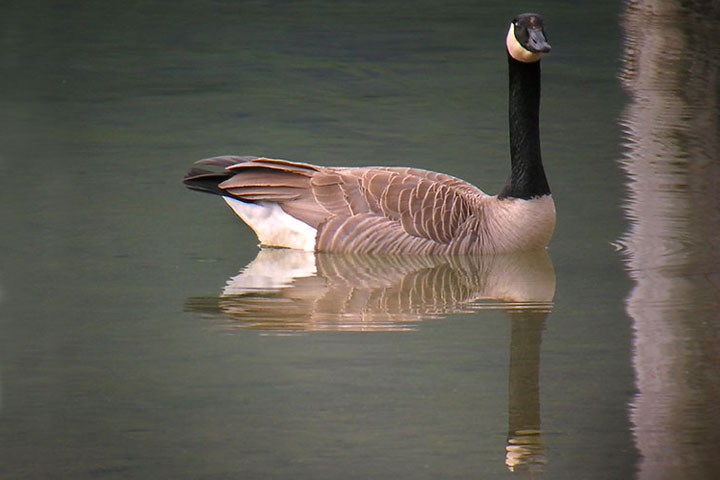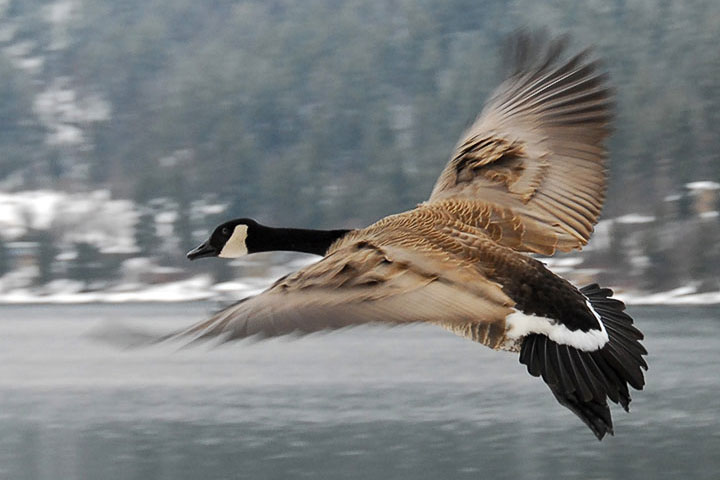Geese
The dominant goose on the Lake is the Canada Goose (about 1970 an entirely white goose waded ashore on a beach I was at, but I expect it was a domestic escapee). The Canada Goose was unknown around the Lake up until the late twentieth century; I saw them first, flying in V-formation over the West Arm about 1972. They were exotic and beautiful at the time. As with many other locations, they are now present around the calendar: because the Lake rarely freezes, the local geese don’t bother to migrate.
 It’s official: When there is a need, harassing geese is fine. Clearly, the City of Nelson feels that sports has such a need.
It’s official: When there is a need, harassing geese is fine. Clearly, the City of Nelson feels that sports has such a need.
The Canada Goose is at once one of the loveliest, and most despised bird on the Lake; certainly, it is the most controversial. More defensive strategies are launched against the Canada Goose, than against any other local bird; the window bashing of the robin is both ephemeral and mild by comparison. The problem, of course, is that the goose’s beauty in flight, and its loveliness while swimming, is more than offset by the filth of its endless droppings on beaches and lawns. A single goose is a veritable poop machine; so just think of the consequences when, not just one of them, but the whole enemy fleet manages to establish a beachhead.
If the Osprey is the pride of the Lake, the Canada Goose is its shame. Sigh..., truly an avis non grata. I have tried all manner of discouragements, but in the end the only thing that works is to be deliberately hurtful: effect missiles are, “your mother was a merganser,” and the stridently calumnious, “your gosling is a passerine.”
 During courting, the male Canada Goose often jockeys for an advantage over a rival by perching on a piling. On this occasion, he is up there with his lassie while a rival was squeaking from the water’s surface below.
During courting, the male Canada Goose often jockeys for an advantage over a rival by perching on a piling. On this occasion, he is up there with his lassie while a rival was squeaking from the water’s surface below.
 Canada Geese use the ground effect to save energy.
Canada Geese use the ground effect to save energy.
 The Canada Goose is a beautiful bird when it is on the Lake or in the air. The extended neck on this goose is not seen in the wintertime; at that time the goose stays warmer by contracting its neck.
The Canada Goose is a beautiful bird when it is on the Lake or in the air. The extended neck on this goose is not seen in the wintertime; at that time the goose stays warmer by contracting its neck.
 Goose chase It is spring (early March) and a rival for a mate is being chased off. The chasing goose is propelling itself through the water with such force that its head and neck is largely lost in the spray.
Goose chase It is spring (early March) and a rival for a mate is being chased off. The chasing goose is propelling itself through the water with such force that its head and neck is largely lost in the spray.
 To become airborne from water, the Goose chase must run across the surface.
To become airborne from water, the Goose chase must run across the surface.
 Family life.
Family life.
 Goslings foraging.
Goslings foraging.
Get the Flash Player to see this player.
Stealth attach A time-lapse camera was set up to catch fog drift, but it caught a visit by geese. They pause at the edge of the beach to size up possible danger, and then rush up to the lawn and feed. (Crescent Bay, June 4, 2005.)
Click picture → play; mouse out → remove caption.
 Canada Geese are unwelcome visitors to beach or lawn.
Canada Geese are unwelcome visitors to beach or lawn.
 When the favoured grass is unavailable, geese dip in the shallows and eat material on the bottom.
When the favoured grass is unavailable, geese dip in the shallows and eat material on the bottom.
 On this cold December day, these Canada Geese face toward the last rays of the setting sun prior to enduing a long cold night. But, there is food to be found throughout the year as Kootenay Lake rarely freezes, so many local geese done’t bother to migrate.
On this cold December day, these Canada Geese face toward the last rays of the setting sun prior to enduing a long cold night. But, there is food to be found throughout the year as Kootenay Lake rarely freezes, so many local geese done’t bother to migrate.
 A goose comes in for a landing on the Lake.
A goose comes in for a landing on the Lake.
 When the grass is covered with snow, geese scrounge in the shallows.
When the grass is covered with snow, geese scrounge in the shallows.
 An agitated goose puts power into its take off.
An agitated goose puts power into its take off.
 It is often commented that geese will fly in a V formation when migrating. But, I don’t often see it around here. This is probably because most of the local geese don’t migrate: they are here year round. And many of their flights are short local ones which take advantage of the ground effect by flying low over the Lake, rather than the extra lift gained by flying on the updraft portion of a neighbour’s wake vortex.
It is often commented that geese will fly in a V formation when migrating. But, I don’t often see it around here. This is probably because most of the local geese don’t migrate: they are here year round. And many of their flights are short local ones which take advantage of the ground effect by flying low over the Lake, rather than the extra lift gained by flying on the updraft portion of a neighbour’s wake vortex.
 Geese in flight are lovely, but they certainly are raucous about it.
Geese in flight are lovely, but they certainly are raucous about it.
 Ruffled coverts Normally, the upper surface of a bird’s wing is smooth. But, as the wing’s angle of attack increases, the airflow can separate from the upper surface of the wing, and lift drops. One solution a bird has is to ruffle its coverts (feathers); this increases turbulence and keeps the airflow tight to the top of the wing and so maintains lift. This is the bird’s equivalence of the little vortex generators used on aircraft wings.
Ruffled coverts Normally, the upper surface of a bird’s wing is smooth. But, as the wing’s angle of attack increases, the airflow can separate from the upper surface of the wing, and lift drops. One solution a bird has is to ruffle its coverts (feathers); this increases turbulence and keeps the airflow tight to the top of the wing and so maintains lift. This is the bird’s equivalence of the little vortex generators used on aircraft wings.
Information from Wikipedia: Canada Goose.
![]()